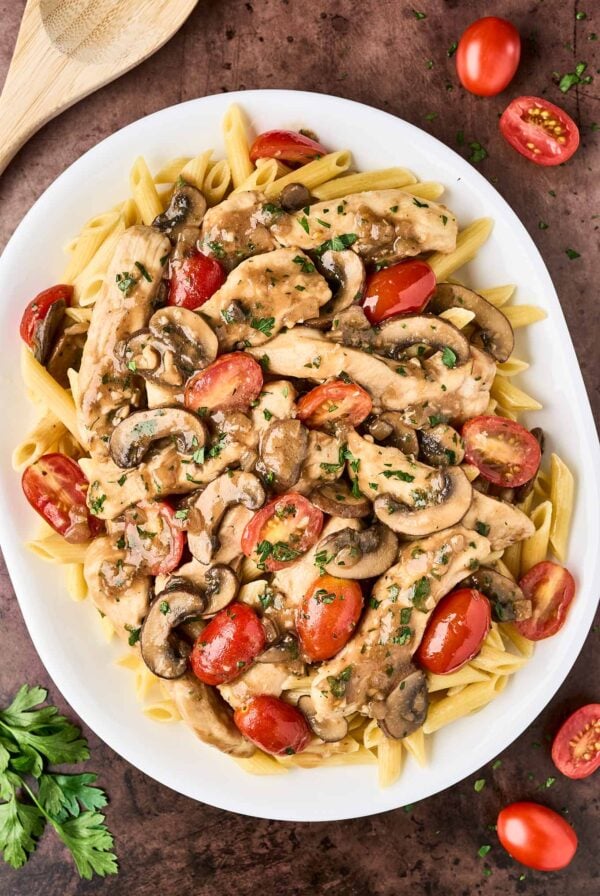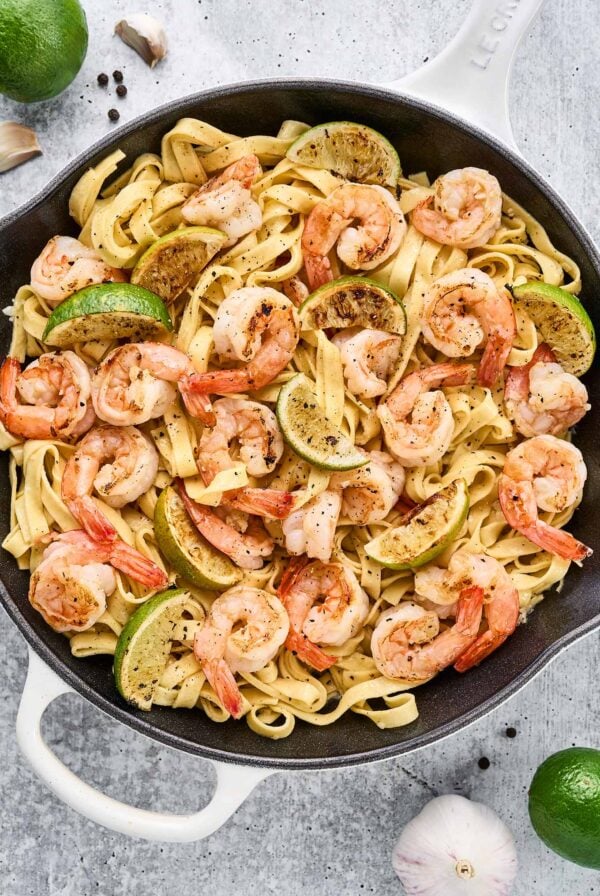This post may contain affiliate links. Please see our disclosure policy.

This easy butternut squash pasta with sage combines some of our favorite fall flavors to create a truly soul-satisfying meatless dinner. Butter, toasted pine nuts, garlic, sage, and Parmesan cheese join the roasted butternut for the ultimate comforting fall-inspired pasta dish.
This pasta with roasted butternut squash is one of our favorite meatless meals in the cooler months when butternuts are at their prime. Thanks to the savory, buttery flavors of the roasted squash and pine nuts, you won’t miss meat at all! However, it’s easy to add a little protein if you’re wanting something a bit more substantial. Our favorites are diced bacon or pancetta. Just cook the bacon or pancetta until crispy, remove from the pan to a paper towel to drain, and then cook your aromatics in the rendered fat (you can add a bit of olive oil if needed). The result is reminiscent of carbonara. Either way, this easy roasted butternut squash and pasta combo will become one of your fall favorites!
Key Ingredients
Here’s what you need to know about the key ingredients in this recipe. The complete list, including quantities, is in the printable recipe card below.

PASTA: Spaghetti is our favorite cut of pasta for this dish, but you’re welcome to use other varieties such as linguine or bucatini. We prefer longer cuts of pasta, but feel free to experiment with penne or cavatappi – really anything you like is fine.
BUTTERNUT SQUASH: We use fresh butternut squash for this recipe, but you can use frozen, as well (see recipe notes). Our local market conveniently sells 16-ounce bags of cubed butternut squash in the produce department, which is a time saver compared with breaking down a whole squash.
PINE NUTS: Pine nuts (aka pignoli) add a buttery, nutty flavor to this pasta dish. They can burn extremely quickly if left unattended, so be sure to watch them carefully when you’re toasting them in the pan.
SAGE: Fresh sage complements the squash beautifully, but we do not recommend using dried sage. If you’re not a fan of the flavor of fresh sage, you can leave it out or substitute fresh thyme.
PARMESAN OR ROMANO: Finishing the dish with freshly grated Parmesan or Pecorino Romano is completely optional, but it’s too delicious not to.
Overview
How to Make Butternut Squash Pasta with Sage
Planning to make this recipe? Here’s a quick overview of how it’s done. Detailed, step-by-step instructions are in the printable recipe card below.
Start by roasting cubed butternut squash with olive oil, salt, and pepper until tender. While that’s in the oven, bring a pot of salted water to a boil for the pasta. In a separate pan, warm more olive oil and briefly cook garlic, sage, and pine nuts, just until the garlic turns golden. Set that aside.


Once the pasta is cooked, save a bit of the water and drain the pasta. Reheat the garlic mixture, stir in some butter, then add the roasted squash, pasta, and a splash of the reserved water. Toss everything together gently, adjusting the seasoning and adding more liquid if needed. Finish with grated cheese on top when serving.

What to Serve with Roasted Butternut Squash Pasta
We like to pair simple vegetable side dishes like oven-roasted cauliflower or asparagus with balsamic brown butter and a side salad with this flavorful pasta main dish.

More Delicious Weeknight Pastas
Looking for more pasta inspiration? Try our Pasta with Caramelized Onions and Sausage for a savory-sweet, satisfying dish. For a meatless option, the Roasted Cauliflower Pasta with Parmesan is hearty and comforting. Or explore bold Mediterranean flavors with our Sicilian-inspired Sardine Pasta with Garlic Breadcrumbs.

Butternut Squash Pasta with Sage
Ingredients
- 10 ounces spaghetti, or other pasta
- 3 cups cubed butternut squash
- 3 tablespoons olive oil, divided
- 3 tablespoons pine nuts
- 4 cloves garlic, minced
- 2 to 3 tablespoons finely chopped fresh sage
- 3 tablespoons butter
- Salt and freshly ground black pepper
- Parmesan or Romano cheese for grating
Instructions
- Preheat the oven to 375°F and line a rimmed baking sheet with parchment paper. If you're not working with whole butternut squash, move on to the next step. Cut the squash in half lengthwise, scoop out the seeds, peel, cut into 1/2-inch cubes.
- Arrange the cubed squash on the baking sheet in a single layer, drizzle with 1 tablespoon of the olive oil and season with salt and pepper. Roast for 15 to 20 minutes, or until the squash is tender when pierced with a knife.
- While the squash is roasting, bring a large pot of salted water to a boil for the pasta.
- Heat the remaining 2 tablespoons of olive oil in a large pan over medium heat. Add the pine nuts, garlic and chopped sage, and cook until the garlic is barely golden, 2 minutes (do not brown). Remove the pan from the heat and set aside.
- Cook the pasta according to package directions, reserve 1/4 cup of the cooking liquid, and drain.
- Return the pan with the pine nuts, garlic and sage to the stove over medium heat. Add the butter and heat until foamy.
- Add the roasted squash, spaghetti and 2 tablespoons of the reserved pasta liquid. Toss gently, season to taste with salt and pepper, and add the balance of the pasta liquid if needed.
- To serve, plate individual portions of pasta and top with grated cheese.
Notes
Nutrition
Nutrition information is automatically calculated, so should only be used as an approximation.













